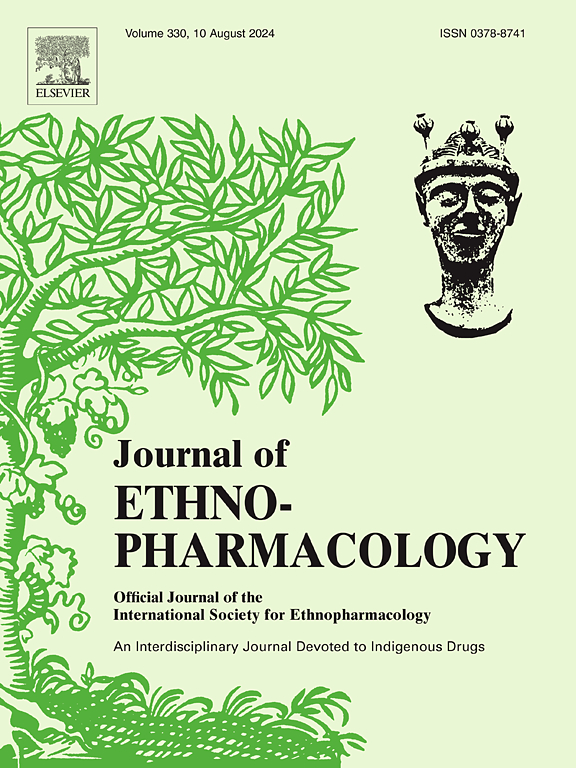Study on the chemical composition, zebrafish toxicity and anti-inflammatory activity of Ecklonia kurome
IF 4.8
2区 医学
Q1 CHEMISTRY, MEDICINAL
引用次数: 0
Abstract
Ethnopharmacological relevance
Inflammation is an important physiological process that serves as the host's defense mechanism against tissue damage, stress, or oxidative stress. As a traditional medicinal and edible plant, Ecklonia kurome (EK) is used to treat galls and scrofula, which is now known as lymphatic tuberculosis and lymphadenitis, but the specific effective medicinal ingredients of EK are not clear, and further exploration is needed for its anti-inflammatory activity.
Aim of study
This study aims to extract, isolate and purify EK, and investigate its pharmacological effects, in order to explore the chemical composition, toxicity and anti-inflammatory activity of EK.
Materials and method
Silica gel, Sephadex gel (LH-20) and other column chromatography methods were used to separate and purify the ethanol extract of EK, and the zebrafish embryo model was used to conduct toxicity evaluation research. The anti-inflammatory activity of monomer compounds was predicted and verified based on molecular docking technology. The lipopolysaccharide induced cell inflammation model was tested to detect NO, reactive oxygen species (ROS), interleukin-6 (IL-6), interleukin-1β (IL-1β), tumor necrosis factor-α (TNF-α), and prostaglandin E2 (PGE2) Study the expression level of indicators and investigate the therapeutic effect of EK on inflammatory cells.
Results
Eight compounds were isolated from EK, namely Ishigoside (1), Squalene (2), δ-tocopherol (3), Phytol (4), Di - (2-ethylhexyl) phthalate (5), 1,3-dilinoloylglycerol (6), Fuchosterol (7), and Mannitol (8). Compound 1 was isolated from EK for the first time, while compounds 2–6 were reported for the first time.; The toxicity test results showed that compounds 1–8 did not produce zebrafish embryonic developmental toxicity at 12.5, 25, 50, and 100 μ M; The molecular docking results showed that the new compound had a good binding effect with inflammatory factors; The anti-inflammatory experiment results of RAW264.7 cells showed that compounds 1–8 did not produce cytotoxicity at 3, 10, 30, and 100 nM, but significantly increased cell viability and inhibited NO in cells, The levels of ROS, IL-6, IL-1β, TNF-α, and PGE2.
Conclusion
The research results indicate that compounds derived from EK can significantly reduce the expression levels of inflammatory cytokines and are safe, suggesting that EK has certain application prospects and can be further developed and utilized.

黑Ecklonia kurome的化学成分、斑马鱼毒性及抗炎活性研究
炎症是机体抵抗组织损伤、应激或氧化应激的重要生理过程。Ecklonia kurome (EK)是一种传统的药用和食用植物,用于治疗胆囊和结节病,即现在所称的淋巴结核和淋巴结炎,但其具体有效的药用成分尚不清楚,其抗炎活性有待进一步探索。本研究旨在提取、分离、纯化莪术,研究其药理作用,探讨莪术的化学成分、毒性和抗炎活性。材料与方法采用硅胶、Sephadex凝胶(LH-20)等柱层析方法对EK乙醇提取物进行分离纯化,并采用斑马鱼胚胎模型进行毒性评价研究。基于分子对接技术对单体化合物的抗炎活性进行了预测和验证。建立脂多糖诱导的细胞炎症模型,检测NO、活性氧(ROS)、白细胞介素-6 (IL-6)、白细胞介素-1β (IL-1β)、肿瘤坏死因子-α (TNF-α)、前列腺素E2 (PGE2)等指标的表达水平,探讨EK对炎症细胞的治疗作用。结果从EK中分离得到8个化合物,分别为石竹皂苷(1)、角鲨烯(2)、δ-生育酚(3)、叶绿醇(4)、邻苯二甲酸二(2-乙基己基)酯(5)、1,3-二烯醇基甘油(6)、狐甾醇(7)和甘露醇(8)。化合物1为首次从该植物中分离得到,化合物2 ~ 6为首次报道。毒性试验结果表明,化合物1 ~ 8在12.5、25、50和100 μ M下均不产生斑马鱼胚胎发育毒性;分子对接结果表明,新化合物与炎症因子具有良好的结合作用;RAW264.7细胞抗炎实验结果显示,化合物1-8在3、10、30和100 nM下不产生细胞毒性,但显著提高细胞活力,抑制细胞内NO、ROS、IL-6、IL-1β、TNF-α和PGE2水平。结论EK衍生化合物可显著降低炎症细胞因子的表达水平,且安全性较好,具有一定的应用前景,可进一步开发利用。
本文章由计算机程序翻译,如有差异,请以英文原文为准。
求助全文
约1分钟内获得全文
求助全文
来源期刊

Journal of ethnopharmacology
医学-全科医学与补充医学
CiteScore
10.30
自引率
5.60%
发文量
967
审稿时长
77 days
期刊介绍:
The Journal of Ethnopharmacology is dedicated to the exchange of information and understandings about people''s use of plants, fungi, animals, microorganisms and minerals and their biological and pharmacological effects based on the principles established through international conventions. Early people confronted with illness and disease, discovered a wealth of useful therapeutic agents in the plant and animal kingdoms. The empirical knowledge of these medicinal substances and their toxic potential was passed on by oral tradition and sometimes recorded in herbals and other texts on materia medica. Many valuable drugs of today (e.g., atropine, ephedrine, tubocurarine, digoxin, reserpine) came into use through the study of indigenous remedies. Chemists continue to use plant-derived drugs (e.g., morphine, taxol, physostigmine, quinidine, emetine) as prototypes in their attempts to develop more effective and less toxic medicinals.
 求助内容:
求助内容: 应助结果提醒方式:
应助结果提醒方式:


